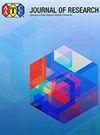Application of Rare Earth Marking on Anti-counterfeiting Waterless/Less-Water Dyeing Technology
IF 1.2
4区 工程技术
Q4 MATERIALS SCIENCE, TEXTILES
引用次数: 0
Abstract
Compared with traditional water-based dyeing, non-aqueous medium dyeing technology has been paid more and more attention in the textile dyeing industry because of its advantages of saving water and chemicals. In order to distinguish and identify water bath dyeing products and non-aqueous medium dyeing products, a traceability technology method for non-aqueous medium dyeing products was established with rare earth elements. First, traceable materials for two typical fibers, polyester and cotton, were selected from five rare earth elements: La, Ce, Nd, Eu, and Sm. Rare earth elements were added to mark products during the non-aqueous dyeing process. Then the rare earth elements content of marked products was detected by inductively coupled plasma–optical emission spectrometry, which was used to identify non-aqueous media products. The influence of this traceability method on the basic properties of dyed fabrics was studied. Compared with traditional anti-counterfeiting technologies such as label anti-counterfeiting and query label anti-counterfeiting, the method of inductively coupled plasma–optical emission spectrometry has a low method detection limit in the range of 0.0204–0.036 mg/kg, and a good relative standard deviation values in the range of 0.69–2.43%. The content of rare earth elements in dyed fabrics was detected by inductively coupled plasma–optical emission spectrometry at 6–7 mg/kg when 10 mg/kg of rare earth elements were employed during dyeing. Therefore, a detection and certification method for non-aqueous dyeing products has been established, which is of great significance to the anti-counterfeiting traceability of non-aqueous medium dyeing technology.稀土标记在防伪无水/少水染色技术中的应用
与传统的水性染色相比,非水介质染色技术因其节水、节药等优点,在纺织印染行业越来越受到重视。为了区分和识别水浴染色产品和非水介质染色产品,建立了非水介质染色产品的稀土元素溯源技术方法。首先,从五种稀土元素中选取了涤纶和棉两种典型纤维的溯源材料:La、Ce、Nd、Eu 和 Sm。在非水染色过程中,稀土元素被添加到标记产品中。然后用电感耦合等离子体-光发射光谱法检测标记产品中的稀土元素含量,并以此来鉴别非水介质产品。研究了这种溯源方法对染色织物基本特性的影响。与标签防伪、查询标签防伪等传统防伪技术相比,电感耦合等离子体-光发射光谱法的方法检出限低,在 0.0204-0.036 mg/kg 范围内,相对标准偏差值在 0.69-2.43% 范围内,具有良好的相对标准偏差。用电感耦合等离子体-光发射光谱法检测染色织物中稀土元素的含量,当染色过程中使用 10 mg/kg 稀土元素时,其含量为 6-7 mg/kg。因此,建立了非水染色产品的检测认证方法,对非水媒染色技术的防伪溯源具有重要意义。
本文章由计算机程序翻译,如有差异,请以英文原文为准。
求助全文
约1分钟内获得全文
求助全文
来源期刊

AATCC Journal of Research
MATERIALS SCIENCE, TEXTILES-
CiteScore
1.30
自引率
0.00%
发文量
34
期刊介绍:
AATCC Journal of Research. This textile research journal has a broad scope: from advanced materials, fibers, and textile and polymer chemistry, to color science, apparel design, and sustainability.
Now indexed by Science Citation Index Extended (SCIE) and discoverable in the Clarivate Analytics Web of Science Core Collection! The Journal’s impact factor is available in Journal Citation Reports.
 求助内容:
求助内容: 应助结果提醒方式:
应助结果提醒方式:


